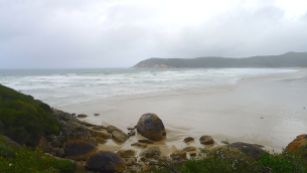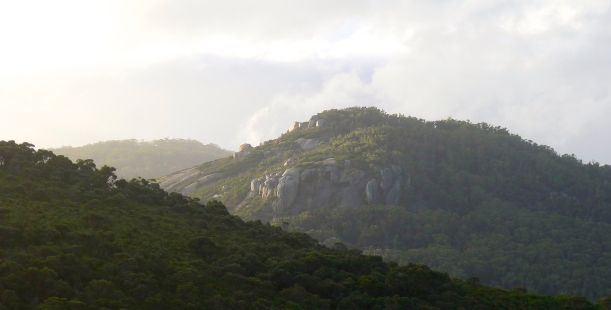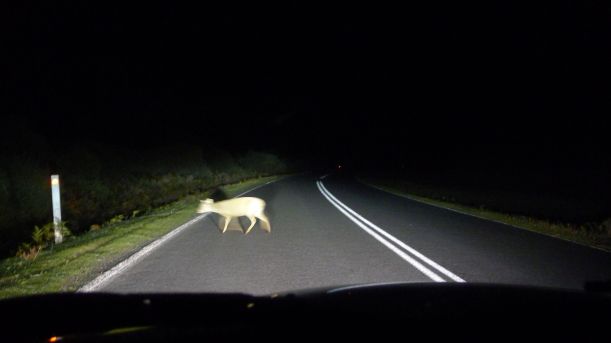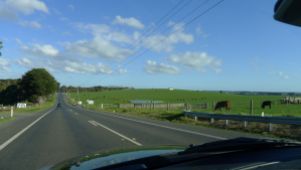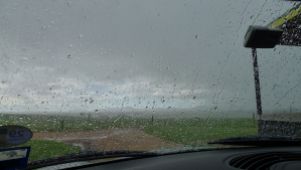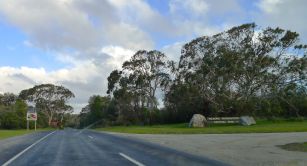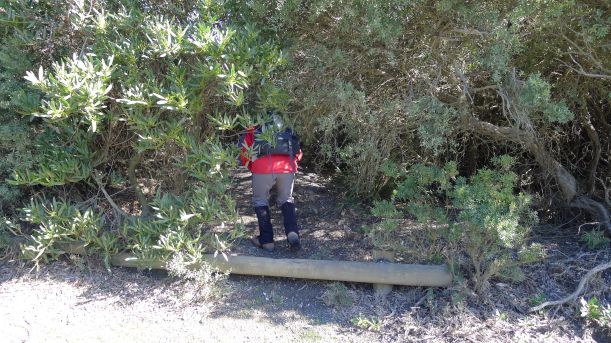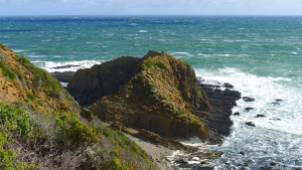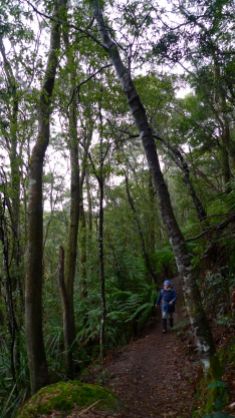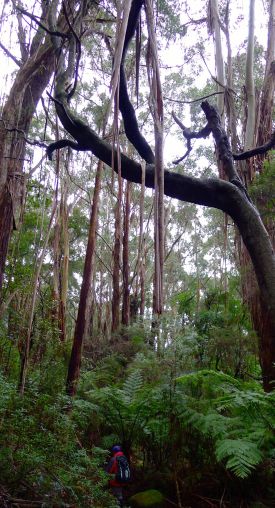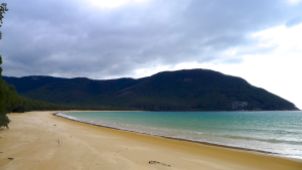And so, after some wet weather and one good days’ walking so far, our Wilsons Prom holiday continues…
Thursday
O is for Oberon – today Oberon Bay and Mt Oberon were our goals.
The track to Oberon Bay starts, very conveniently, between the Visitor Centre and General Store at Tidal River. Our walk started pretty wet and windy (again). After passing behind Norman Beach, the rain eased up slightly and our cameras saw some more action as we walked around Normal Point to Little Oberon Bay.
Little Oberon Bay is stunning. Of all the beaches we saw and of the four we walked on, Little Oberon was by fast the loveliest. White silicon sand, turquoise water, orange rocks, green shrubs – gorgeous! The only downside is that the beach is pretty steep, so I don’t know that it would be a patrolled beach in summer; if not, I wouldn’t recommend swimming there.
Continuing on around the next corner is Oberon Bay. A much longer, less sheltered bay, with yellow sand. Not quite as picturesque, but a much shallower beach and better for swimming – not that I had any desire for a dip; I’d prefer not to experience hyperthermia which was what the wind was promising!
If you cross Growler Creek and continue on down Oberon Bay there’s another camping area. While not deep, I still found the best way of crossing the ‘creek’ (it is still a creek at when it meets the ocean?) while getting the least wet – yes, despite wearing hiking boots and gaiters, I still wanted to avoid getting overly wet with salty water.
We lunched by Growler Creek after passing another couple coming back – the only two other people we saw along this walk. Like so many people we see out walking, they weren’t carrying anything. From Growler Creek it’s over 6km back to Tidal River – that’s 12km+ they’ve come without even water – that’s pretty silly. Water is the primary reason why Stephen and I each wear a backpack, even though we sometimes may not drink more than a quarter of what we take.
Today we were joined for lunch by a hopeful raven (most likely Corvus coronoides), but it got no satisfaction from us.
Despite the weather looking like it was closing in again, we were spared too much more rain on the walk back. We took the short path out to Norman Point, but the sun was not in the best position to get great photos.
Instead of heading straight back to the car when we reached the Tidal River camping area, we deviated slightly and followed the loop road around the back of the school camping area to check out the Wilderness Retreats – the 5 or so ‘safari-style’ tent/cabins they have as a deluxe camping option. While far more comfortable looking than the small cabins for two located closer to the Visitor Centre, we still think there are some major draw backs to staying in-park compared to staying at somewhere like Black Cockatoo Cottages just outside the park. (Comparison at the end of the post.)
Walking back to the car parked near the Visitor Centre, we saw many wombats! Wombats clock on from 3:30pm it seems. And there was a nice kookaburra, too.
We arrived back at the General Store at 3:45pm ready for a post walk icecream! Just in time, too – despite the sign saying they close at 4pm, they locked the door to all comers at 3:50 – not a minute after Stephen went in. The next three people who turned up were a bit confused and disappointed! Fortunately they seemed to know people who were already in the shop buying things. Too bad if not!
I wonder if this ‘hospitality’ is the same during the peak summer months?
Here are the map and stats from the Oberon Bay walk. This is from Stephen’s garmin because I didn’t reset mine between walks, and so recorded not just both walks we did today, but the drive back to the cottage afterwards. A lesson for next time.
While I was waiting for Stephen to come out of the General Store, I couldn’t help but notice how lovely Mt Bishop looked in the afternoon sun…
So it wasn’t until about 4:30pm that we headed up to the Telegraph Saddle (Mt Oberon) carpark to then walk up to the summit of Mt Oberon to take sunset photos – arguably the most iconic photos taken of the park, possibly along with the orange stained rocks of the beaches and Tidal River.
Being winter, we realised that we didn’t have much time to waste getting up there. The sign at the carpark says the road is 3.4km; the walk notes on our map said 6.5km return and to allow 2hrs. With sunset just after 5:30, it sounded like we might be cutting it fine! So, after one photo at the start to the road, the camera went back into my pocket; time to focus on walking. Steel springs! It was a quick march the whole way. I arrived at the top of the road in 45min; hot and red-face – but before the sun had set!
(Incidentally, the distance is roughly the same as that we walk home from the city each night, which takes us roughly 35min… but home isn’t 347m above the city!)
From the top of the road, there’s one last one effort to make it up to the actual peak – some stairs and steps carved into the rocks behind the transmission towers. This last little effort is a little bit like an easier version of the very top section of Mt Warning in northern New South Wales when you get to the chain section. You think you’re done, then there’s just a wee bit more before you get to the lookout!
But then you are rewarded with an amazing 360 degree view over the park and Bass Strait and of the setting sun. What a view!
We weren’t the only ones up there. There was a group of half a dozen asian (Japanese?) students who were jumping around as though they were getting a bit cold. Funny that. Fortunately it wasn’t blowing a gale – given the weather of the last couple of days (including gale force winds up to 113km/hr) we were supremely lucky to have such perfect weather.
The light of a shining half moon helped guide us the down the road back to the car.
Here are the map and stats from Stephen’s walk up to the summit. I’m rather disappointed mine aren’t so easily decipherable – here it is incase you want to have a look for yourself.
It was a slow drive back to Black Cockatoo Cottages – maximum speed was only about 60km/hr due to the abundant wildlife. The majority of the wallabies and wombats we saw were happy to keep munching by the side of the road, or turned away as we neared, but a couple of wallabies had different ideas and wanted to cross in front of us. And then there were the deer. Sambar, to be precise.
And the possum sitting on the road with it’s back to us – I didn’t even see it! I saw the swamp wallaby on the other side of the road, but luckily Stephen somehow saw the brushtail possum. It’s dark brown-black fur blending in with the bitumen of the road very well. We came to a complete stop and had even waited a minute before it decided maybe the road wasn’t where it wanted to be and moved off into the bush. Lucky for it that it’s an Australian possum, and not a New Zealand possum…
Despite the wallabies, wombats, kangaroos, emus, possum, deer, rabbits/hares, and an unidentified bird that wanted to swoop across the road just as we were driving by, we made it home without killing anything. Bit of a relief, really.
Friday
Fantastic sunrise this morning – and given it was my last opportunity to photograph it, what more inspiration did I need? I grabbed the tripod and got going.
I had no idea what the time was, but I’d taken a couple of photos when I heard the dairy farmer next door start his day, so… early enough.
The only drawback with having such a magnificent view from you bed is seeing what you’ll miss if you close your eyes. Pity I couldn’t take these photos from bed! But it wasn’t quite as cold as previous mornings – still cold enough, but again being out of any wind or breeze makes it much better.
I believe that the mark of a really good holiday is that as you leave you’re already asking yourself ‘When can I/we come back?’.
So, would we go back?
Hmmm, well…
Wilsons Promontory National Park is spectacular and beautiful and deserves all the lovely things that are written about it, but (and there’s a BUT)… there’s a lack of adequate services within a reasonable distance of the park.
Basic accommodation and scenery are not all that tourists looking for in a holiday destination. At the moment I really feel that’s all that is on offer if you want to stay somewhere in or close to the national park.
Since visiting the park currently requires you to take your own food supplies with you, it’s good to know in advance where you can buy supplies should you run out, or if you’ve forgotten a key ingredient – or your toothbrush!
From Tidal River, the closest general stores are:
– Tidal River General Store: next to the Visitor Centre (limited stock, overpriced and closes earlier than advertised)
– Yanakie General Store: ~1hr return drive (we didn’t visit but I wouldn’t rely on it to be better than Tidal River. Check opening times.)
– Fish Creek General Store: ~2hr return drive (undergoing renovations when we visited and had very limited stock.)
– Foodworks at Foster: ~2hr return drive (we didn’t visit but it looked to be a larger (and better?) option than the two above)
– Michael’s IGA at Leongatha: ~4hr return drive (fantastic, but not somewhere you’d go just for a litre of milk)
(NOTE: take 1hr off return driving time if staying at Yanakie. Add at least 10min per direction if traveling through park after dark.)
There are also no take away food options for dinner after Foster. I don’t know what the cafe may provide in the summer peak – maybe fish & chips? Though by the look of it don’t expect restaurant quality dishes. In low season the cafe closed for the day even before the General Store did.
Should you arrive at your destination and find yourself low on fuel, you can apparently refuel in Yanakie (just on the Park boundary). We made it back to a BP service station in Leongatha to refuel.
Recently, the state government has passed a bill making Victorian National Parks open to proposals for environmentally sensitive developments like those that exist along the Overland Track in Tasmania and the Milford Track in New Zealand – both of which Stephen and I have completed with the private guiding companies and loved. Despite these stirling examples of sensitive in-park development, the general public either don’t know or don’t appreciate how these private guided walks are operated, and/or they do not trust the government to limit the private interests to developments of just this nature. (I also have some concern about the latter, but until an actual proposal has been made, we won’t know for sure.)
There has been – and still is – a lot of resistance from various groups to the thought of opening up our national parks to commercial development. Victorian National Parks Association (an NGO – not Parks Victoria) are totally against it. Friends of The Prom (FOTP) are organising a rally in November to show their protest against the idea. “Hands off” is their key message. While these groups do a lot of good in raise awareness about national park issues, and the FOTP have certainly done much to help the park recover from recently natural disasters, it does seem that people are assuming the worst about any potential commercial development (i.e. that their beloved parks are going to be trashed by thoughtless, rich interlopers attracted by large hotel chains who are only out to make money from what doesn’t belong to them).
However, with the construction a few small private huts just off existing tracks (as is the case along the Overland Track), walkers like Stephen and I would have the opportunity to see more of the park than is currently within our reach. Small groups (8-10 guests) of guided walkers are not going to trash the park. At an all-inclusive cost of $400-600pp/night (based on 2013/14 season prices charged by the private operators of the guided walks along the Milford and Overland Tracks), this kind of experience attracts people who really want to experience and appreciate the best our premium national parks have to offer, and who don’t care to (or can’t) do the camping option.
With or without in-park development, a modest-sized hotel just outside the park (which would definitely include a restaurant and possibly also a cafe) would also make visiting the Prom easier. I can think of any number of places – not all of them high-end – that have similar arrangements:
Kingfisher Bay Resort – Fraser Island NP (Qld)
Tangalooma Island Resort – Moreton Island NP (Qld)
Carnarvon Gorge Wilderness Lodge – Carnarvon Gorge NP (Qld)
O’Reilly’s – Lamington NP (Qld)
Freycinet Lodge – Freycinet NP (Tas)
Falls Creek – Alpine NP (Vic)
Royal Mail Hotel, Dunkeld – Grampians NP (Vic)
Halls Gap – Grampians NP (Vic)
Thredbo – Kosciusko NP (NSW)
Ayres Rock Resort – Uluru-Kata Tjuta NP (NT)
Ben Lomond Village – Ben Lomond NP (Tas)
Cradle Mountain Lodge / Chateau – Cradle Mountain-Lake St Clair NP (Tas)
Remember, it’s not just Victorians and 20-something backpackers who want visit. The desire to see the worlds best National Parks is experienced by everyone at some point who has been touched by the beauty of nature. If you were travelling from interstate or overseas and were told to bring all your food for the duration of your stay with you – how would you manage?
One of the pioneers of national parks in Australia was Gustav Weindorfer in Tasmania, who was instrumental in the formation of the Cradle Mountain – Lake St Clair National Park. He didn’t just want to protect this place of great beauty and environmental significance, but share it with people. The (and his wife Kate) built a lodge and brought in guests. They didn’t try to hide their find. They understood that the more people who visit and fall in love with a place, the greater the number of people who will then be willing to protect that place, and places like it.
– – –
As mentioned above, this is my comparison table that I hope may be helpful for couples thinking of visiting Wilsons Promontory:
Comparison between Accommodation options we considered at Wilsons Promontory
| Park Victoria’s Wilderness Retreats,Tidal River | Private Accom – Black Cockatoo Studio Cottage, Yanakie | |
| Closer to start of most walks | Drive 30-40min to/from walks | |
| No view | Stunning sunrises from bed | |
| Native wildlife at your doorstep | Birdlife and cows | |
| Limited privacy | Privacy | |
| Ensuite (not sure if this includes a shower) – shower & laundry facility block separate | Full bathroom & laundry facilities within the cottage | |
| Bring all food with you – limited general store in Park | Bring all food with you – nearest general store is ~5min drive at Yanakie | |
| Fully equipped communal kitchen tent. | Fully equipped kitchen in cottage | |
| Bar fridge in sleeping tent, shared full-sized refrigerator in communal kitchen tent. | Full-sized refrigerator in kitchen | |
| Shared BBQ (electric) area. | BBQ (electric) on veranda. | |
| Cost (as at Aug 2013) $302.50 per night | Cost (as at Aug 2013) $140-160 per night |
If/ when we go back, we plan to walk to the Lighthouse and stay a night or two (there’s no minimum stay, but maximum stay is 2 nights – yep, go figure), but otherwise we’d be staying outside the park at in the studio cottage at Black Cockatoo. (I can’t pass up that view!) By ourselves there’s no way we’re going to get to see much of the rest of the park that you can’t do as a return day walk.



